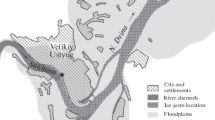Abstract
During the period of river ice thawing and breakup process (termed as “ice cover thawing-breakup”), vast amount of water stored in ice-covered river reach will be released comparing to that under open flow condition. The flow routing process during river ice thawing-breakup period will be different from that under open flow condition, since water stored in and channel from ice thawing-breakup process and flow routing process are very complicated. If the flow routing process during river ice thawing-breakup period can be predicted, it will very important for flood protection in the downstream river reach. In present study, water released from ice cover thawing process is considered as the lateral inflow to the channel flow during propagation process of flood wave from upstream to downstream. A model for the flood routing process during river ice thawing-breakup period has been developed based on the Muskingum hydrologic method. Using the modified Muskingum model, the routed outflow hydrograph has been determined along the Baotou Reach of the Yellow River during river ice thawing-breakup period. Results showed that the simulated hydrographs using developed model agree well with those of field measurements.










Similar content being viewed by others
References
Bao H, Li Z, Wang L (2007) Study of flood forecasting for upper reaches of the Huihe River above Lutaizi. J China Hydraul Eng 2007(S1):445–453
Beltaos S (ed) (1995) River ice jams. Water Resources Publications, U.S.A.
Beltaos S, Burrell B, Ismail S (1996) 1991 ice jamming along the Saint John River: a case study. Can J Civ Eng 23:381–394
Cunge JA (1969) On the subject of a flood propagation computation method. J Hydraul Res 7(2):205–230
East China Institute of Water Resources (ECIWR) (1978) Flood forecasting methods for humid areas in China. China Water and Power Press: 81–85
Gill MA (1978) Flood routing by the Muskingum method. J Hydrol 36(3):353–363
Khan MH (1993) Muskingum flood routing model for multiple tributaries. Water Resour Res 29(4):1057–1062
Li K, Fu L, Hu Y, Lu Y (2012) Determination of the value ranges of parameters C0, C1, and C2 of Muskingum method. South-to-North Water Divers Water Sci Technol 10(5):43–45
Moghaddam A, Behmanesh J, Farsijani A (2016) Parameters estimation for the new four-parameter nonlinear muskingum model using the particle swarm optimization. Water Resour Manag 30(7):2143–2160
Mohan S (1997) Parameter estimation of nonlinear Muskingum models using genetic algorithm. J Hydraul Eng. https://doi.org/10.1061/(ASCE)0733-9429(1997)123:2(137)
Niazkar M, Afzali SH (2016) Application of new hybrid optimization technique for parameter estimation of new improved version of Muskingum model. Water Resour Manag 30(13):4713–4730
O'Donnell T (1985) A direct three-parameter Muskingum procedure incorporating lateral inflow. Hydrol Sci J 30(4):479–496
Ostad-Ali-Askari K, Shayannejad M (2016) Flood routing in rivers by Muskingum’s method with new adjusted coefficients. Int Water Technol J 6(3):189–194
Sui J, Karney B, Fang D (2005) Variation in water level under ice-jammed condition -field investigation and experimental study. Nord Hydrol 36(1):65–84
Sui J, Wang J, He Y, Krol F (2010) Velocity profiles and incipient motion of frazil particles under ice cover. Int J Sediment Res 25(1):39–51
Wang K, Wang J, Sui J (2018) Deformation of flood wave during ice river period in the Ningxia-inner Mongolian reach of the Yellow River. J China Hydraul Eng 49(7):869–876
Wang J, Wu Y, Sui J, Bryan K (2019) Formation and movement of ice accumulation waves under ice cover–an experimental study. J Hydrol Hydromech 67(2):171–178
Yao H, Qin F, Shen G, Dong X (2007) Ice regime characteristics in the Ningxia Inner Mongolia reach of Yellow River. Adv Water Sci 18(6):893–899
Yapa PD, Shen HT (1986) Unsteady flow simulation for an ice-covered river. J Hydraul Eng 112(11):1036–1049
Zhang F, Xi G, Zhang X, Wang G, Huang R (2015) Simulation of channel-storage increment process in ice flood period. Adv Water Sci 26(2):201–211
Acknowledgements
This study is supported by the National Natural Science Foundation of China (No.51879065, No.51679102). The authors are grateful for the financial support.
Author information
Authors and Affiliations
Corresponding author
Additional information
Publisher’s Note
Springer Nature remains neutral with regard to jurisdictional claims in published maps and institutional affiliations.
Rights and permissions
About this article
Cite this article
Yang, W., Wang, J., Sui, J. et al. A Modified Muskingum Flow Routing Model for Flood Wave Propagation during River Ice Thawing-Breakup Period. Water Resour Manage 33, 4865–4878 (2019). https://doi.org/10.1007/s11269-019-02412-7
Received:
Accepted:
Published:
Issue Date:
DOI: https://doi.org/10.1007/s11269-019-02412-7




